I Am Strangely Glad to Get Back Again to You and Wherever You Are Is My Homeã¢â‚¬â€my Only Home
For anyone over 40 (or maybe 30), having a music collection probably means that, in addition to racks of CDs and ridiculous piles of MP3s, you're as well sitting on bookshelves (or "borrowed" milk crates) full of vinyl LPs. Hundreds of pounds of space-consuming, damage-prone vinyl. LPs were music yous could touch, with glorious full-color 12″ anthology fine art, meandering liner notes, and the practical interest of lowering needle to plastic. Long-playing records represent an era when music was less disposable – we actually sat down to heed, rather than treating music as a backdrop to the rest of life. Dragging a rock through vinyl was not some kind of nostalgic beloved affair with the past – it was just the way things were. The price of access was pops and scratches, warped discs, having to get up in the center of an album to flip the disc, cleaning the grooves from time to time, and getting hernias every time you moved to a new flat.

I personally held onto around 700 records fabricated before the 90s, in add-on to a few boxes of records my parents left in my intendance. Virtually of my CD purchases from the 90s and 00's had been ripped long agone, only the LPs were locked in limbo – wasn't listening to them, but couldn't acquit to let get, either. In 2011, I finally decided it was fourth dimension to hunker down and digitize the stacks, to un-forget all those excellent records.
Digitizing LPs has about nothing in common with ripping CDs. Information technology'due south a slow process, and a lot of work. But it can exist incredibly rewarding, and going through the process puts yous back in touch with music the style information technology used to exist played (i.e. it's a slap-up nostalgia trip). In this guide, I'll cover the procedure of prepping your gear, cleaning your records, and capturing every bit much of the essence of those old LPs as possible, so you can enjoy them in the context of your digital life.
Setting Upwards

Here'southward the full general roadmap – I'll get into each of these separately below:
- Tune your table
- Make the connexion
- Make clean your vinyl
- Option the right software
- Decide what to rip and what to toss (and what to re-purchase)
- Pick an output format
- Establish a workflow
- Bargain with noise
- Export tracks
Tune Your Table (and Cartridge)
Considering of the time involved, yous want to go through this process exactly once. If you're going to do this matter, do it right. You need to think at present about a listening picture bigger than your iPhone and earbuds, bigger than your desktop calculator speakers. The "ultimate" goal is that you lot can play the final event through the best amp and speakers you can notice, and it'll be duplicate from the original (or every bit close to it every bit possible). In fact, information technology may even be better, if you filter out pops and scratches carefully. Who knows what kind of home stereo you're going to have x or thirty years from now? Recall long-term.
So if the process is so time-consuming, why not just re-purchase everything? If you're sitting on a lot of LPs, buying a new digital re-create of every album is going to exist expensive (even though a lot of older LPs are available at emusic.com and mp3.amazon.com for $five-$7). Sure, your time may exist worth more than what information technology takes to digitize everything yourself, but non everything needs to be an ROI/time-is-money calculation, correct?
If you lot haven't thought much most your turntable for ii decades, accept fourth dimension out to brand sure it'due south in top condition before beginning. It makes no sense to spend dozens or hundreds of hours digitizing if the audio quality is going to be diminished for want of a new needle, or because your cartridge hums or your turntable transmits motor dissonance. Think of yourself as an archivist, creating a drove you'll exist proud to laissez passer down to your children.
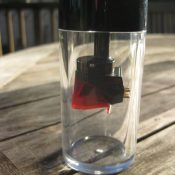
If you're not sure whether your turntable is up to snuff, take it to a qualified audio store and ask their opinion. You might desire to take them do an alignment and lubrication, or let them talk you into a new turntable.
Hooking Upward – The turntable-figurer connection
Traditional turntables output sound at a level lower than standard line-level. In other words, you lot can't merely plug a turntable's RCA cables into your figurer and wait it to work. Yous'll need either a dedicated phono pre-amp or a turntable with a built-in line stage or USB jack.
There are a lot of turntables on the market place with congenital-in USB connections, many of them specifically designed for digitizing old collections. But many of them are inexpensive pieces of lightweight junk, and just not worth it (especially the inexpensive models). In most cases, y'all'll be amend off with a well-designed traditional table and outboard analog-digital converter (ADC).
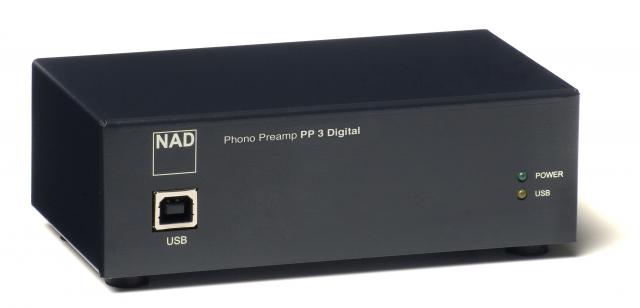
There are a dozen or then USB phono pre-amps available on Amazon, ranging from $fifty-$1200. My darling wife got me the NAD PP-3 for Christmas (effectually $200, simply no longer available). Since information technology has both USB and RCA outputs, I'll withal be able to utilise it in the home stereo for standard LP playback once the digitization process is complete (though it'll exist continued to my computer for the foreseeable future :) Honestly, I tin't tell you lot what to await for in a USB ADC/pre-amp. In general, yous get what you lot pay for. The cheapest one (of anything) is almost never the right conclusion, but the really high-finish audio stuff works in a realm of sub-sonic quality differences that my ears simply can't hear. If you're at a loss, but get for something priced in the heart range, from a manufacturer with a decent reputation.
In one case connected to my iMac, I went to the organisation's Audio Preferences panel and selected the NAD every bit the input (I did accept to reboot the machine before it was recognized, surprisingly). Afterwards that, output from the turntable was available to all the audio capture software I tested.
Make sure the turntable is resting on a solid desk and is non overly sensitive to footsteps in the room – you don't want perceptible warbling in the audio when walking nearby (if you lot have kids, make sure they know to walk softly when daddy's decorated ripping :). You lot don't want to find out that some of your recordings were marred by vibrations months later, subsequently you lot've finished the process and ditched some of your LPs. If you lot're in a room with a boisterous floor, consider setting upward your digi-station in another room, maybe with a laptop dedicated to the process.
Cleaning Your Vinyl
Grit = Noise
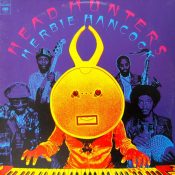
DAK has a dandy page total of electron microscope photographs showing LP surfaces before and after cleaning with their organization. If you don't recall your records are dusty, or that dust and static tin can affect recording quality, give it a read.

Dust in record grooves, equally seen with an electron microscope. Check the DAK page for more examples.
There are a number of vinyl cleaning systems out at that place, from simple brushes to carbon micro-fibers to full-on record vacuuming systems. I wanted to clean, but wasn't going to become all mad scientist well-nigh it. Found my onetime Discwasher castor from the 70s, still in amazingly expert shape after all this time, but the fluid bottle was dry. Using fluid is important not just for cleaning purposes, merely also to dampen or remove residual static accuse. A chip of searching turned upwards dozens of dwelling-brew fluid recipes, and I settled on this one:
- iii parts distilled water (triple distilled, de-ionized)
- 1 part Isopropyl alcohol, 91% lab grade
- A few drops of photographic wetting amanuensis €“ if possible Triton Ten-100, Triton X-110 or Triton X-115 or Monolan 2000, not Kodak Photoflo which is €˜reputed€™ to leave a residue (though used by some). Recommended is 12 drops per gallon or ii-3 drops per litre, though some employ upwardly to 8 drops per litre. If y'all add too much, the fluid gets sudsy on the record.

Before recording each side, I eject two lines of fluid onto the leading edge of the brush and do a slow, steady roll from wet side to dry side. Results have been nifty, and I've pulled visible amounts of dust out of virtually LP side I've cleaned.
Everything you can do to extract all the audio goodness possible out of your LPs is worth doing (within reason). Don't skip the cleaning process!
Selection the Right Digitizing Software
Technically, you could use any audio software capable of digitizing 2-track audio and outputting to MP3 or other formats. But in that location's a heck of a lot more to the process than capturing audio. Digitizing LPs is an entire workflow, which involves:
- Capturing
- Finding rails boundaries/splitting tracks
- Looking up metadata (album title, artist, twelvemonth, genre, private track titles, album fine art)
- Cleaning upwards clicks and scratches
- Cleaning upwardly other racket (hum, etc.)
- Outputting to multiple formats
If your software can't help with every office of that process, you're going to waste matter a lot of time doing things manually that should be semi-automatic. You lot want software that's congenital specifically for the LP/cassette digitization workflow. And that means that software such as Audacity, Garage Ring, and even Pro Tools are out of the running. I tin't stress this enough – do not waste your time with general-purpose audio-editing software. Use software purpose-congenital for digitizing LPs.
Since LPs can't be looked up automatically in a database like iTunes and other ripping software does with CDs, yous need software that can make the track naming process easier. I tried a few apps before settling on AlpineSoft's Vinyl Studio. A trial version came with the NAD pre-amp, and I was diddled away by how much easier it made things than the Audacity-based workflow I had been working with previously. Bachelor for both Windows and Mac, VinylStudio does everything listed to a higher place, and uses a tabbed interface to segment the workflow intuitively. It's not gorgeous by mod Mac software standards, but it does exactly what it claims to do, and it does it actually well. Two features lonely make information technology completely worth the $thirty:
- Integration with external rail databases. Tell VinylStudio the artist and album proper noun and it'll attempt to find that album in MusicBrainz, Discogs, and other open source/collaborative music databases. Select ane its search results and VinylStudio will employ that data to propose track breaks. Which means you don't take to find all the track breaks yourself, and you lot don't accept to type in all the rail names past manus. If it tin't find a lucifer, VinylStudio has a "Scan for track breaks" characteristic that will do its best to mark the quiet sections betwixt tracks. You'll all the same take to type in rails names manually in that case, but it'southward still a fourth dimension saver over finding track breaks manually. More than on this procedure later.
- Start/stop recording on needle up/down. One matter you don't desire is to have to sit down there babysitting the turntable, waiting for one side to stop and so y'all can pause recording and get-go the other. VinylStudio listens for needle downwards and up thresholds, which means you can leave the room and trust that recording volition have stopped when y'all return after dinner. When you lot have hundreds of LPs to import, this feature alone is worth the price of admission.
For albums that VinylStudio couldn't find in third-political party databases, I also got a scrap of assist getting everything tagged correctly with a $30 app called CoverScout, which examines your collection for missing artwork, then looks it upwardly in Google Images, Amazon, and other services. A bit pricey, but I ended up with hundreds of albums without artwork, and CoverScout helped me get them all busy – money well spent.
Of course I didn't attempt everything on the market – I stopped looking when I institute VinylStudio. Got others to recommend? Leave a notation in the comments.
What to rip and what to toss (and what to re-purchase)
Because the process is so time-consuming, yous'll probably desire to start by eliminating LPs that y'all only don't intendance about anymore. I personally made three piles:
- Discard (sell)
- Encode, then discard
- Encode, and so continue
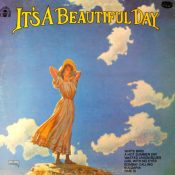
In most cases, the decision about what to re-buy was based on the status of the LP. If, after digitization and cleaning, I notwithstanding wasn't happy with the sound, I'd delete what I'd merely digitized and become find a pristine copy at emusic.com or mp3.amazon.com (or every so often at iTunes, though their prices are nearly ever higher). iTunes sells music encoded at 256kbps AAC (equivalent to 320kbps MP3), while emusic and mp3.amazon sell music at a fairly high VBR (variable bit charge per unit), which means the bitrate goes up for complex passages and downwards for simple passages. More than on VBR vs. CBR later, but suffice to say the quality is very adept and I'thousand happy with them.
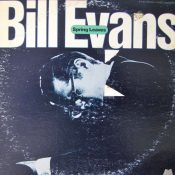

Fakes
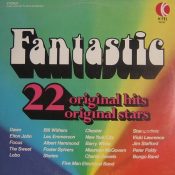
At start I idea it was just me, but do a search similar this and await for the collections with one-star ratings. Click on those and read the customer comments – something very weird is going on here, and I'thou not sure what. I wrote to Amazon and complained and they cheerfully refunded the coin. I was impressed by that, merely still not certain how to go along with the KTEL/Ronco collections. Will probably merely bite the bullet and exercise them manually.
I have not experienced this problem with whatever other purchased downloads – merely the 70s collections.
Picking an output format
iii,000-yr-onetime Egyptian papyrus is nevertheless readable today. Just 1990s give-and-take processing documents written in WordStar? Images made on a 1978 Atari? Video created on an early version of Windows? Proficient luck finding a mode to read whatever of those formats. You lot run into where I'm going with this. LPs were entrenched in our culture for decades, and I look it will be easy to find a turntable capable of playing any of the records made throughout the 20th century for many decades to come. But file formats are somewhat transient. As better ones come forth, the former ones slide into obsolescence.
I had 2 criteria in selecting an output file format: I wanted the best quality possible while using a reasonable amount of disk space, and I wanted to not feel paranoid that the file format would be obscure in 20 or 30 years. I'1000 creating an archive here, and that means I want this stuff around for a very long time to come up. I desire to be able to pass this music on to my son someday.
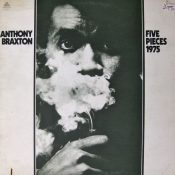
Some other factor that tipped the scales against lossless for me was the fact that dynamic range has been so squashed out by modern recording techniques. I've written about this before; merely the point is fabricated well in in this cnet commodity:
The loudness wars of the 90s ruined all the quality gains digital music had made – listening to a recording as a FLAC or Apple Lossless file can't disengage dynamic range compression or overzealous equalization.
It's true that most of my LPs were originally recorded before the 1990s, and so this problem won't affect most of my stuff — but I do have a number of more modernistic records for which it is a gene. Bottom line is that I just can't perceive enough deviation between FLAC/ALAC and high-bitrate MP3 to make the extra disk space and the prospect of obsolescence worth it.
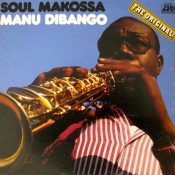
For more than on MP3 compression, see CBR vs VBR, below.
If y'all're willing to invest in a behemothic difficult drive (and have a manner to go along information technology backed up off-site), you have another pick: Relieve the original uncompressed version in a digital storage vault, and put the compressed version in your regular library for daily use. In VinylStudio, you start with "Recordings" which should exist in a high-quality uncompressed format. Yous then output your cleaned upward audio at the end of the process. And then, in essence, this two-format procedure is broiled into the VinylStudio workflow, if yous desire it to exist. But I didn't go that far – I only kept the loftier-bitrate MP3s and ditched the uncompressed originals. Living unsafe, correct?
Here are notes from my listening tests as I was deciding on an output format:
Bought a copy of Steely Dan's "Aja" from the iTunes store (256kbps AAC) for "reference", and then digitized versions of the aforementioned album from LP with:
- Onetime Shure cartridge, uncorrected VBR0 MP3 (pretty adept only had slight hum)
- New Ortofon cartridge, uncorrected VBR0 MP3 (more range, less hum – expert buy!)
- New Ortofon cartridge, corrected VBR0 MP3
By "corrected" I mean "with pops and scratches removed" – a process that cleans upwardly the indicate quite a fleck, only with a very (very) slight impact on dynamic range. Of course the purchased AAC version sounded the cleanest, being completely free of surface dissonance, only the LP versions felt, richer, and more live.

In a second experiment, the guinea squealer was a 180-gram audiophile recording of Sonny Rollins' "Way Out West" (a truthful treasure of jazz). For this i I did four encodings with the new Ortofon cartridge:
– ALAC corrected
– ALAC uncorrected
– MP3 VBR0 corrected
– MP3 VBR0 uncorrected
I and so de-waxed my ears, plunked down in the sweet spot in the living room, cranked it up, and did my closest listening, trying to decide whether I wanted to go corrected or uncorrected from here on out. Same conclusions – I similar the click-corrected audio ameliorate for most LPs. Fifty-fifty when dealing with a really high quality LP in good physical condition, click-reduction removes enough surface noise to enhance the overall experience.

Since the ALAC versions are more than than twice as big filesize-wise, and because of my hesitancy about the time to come/compatibility of ALAC, I made my final decision: I'd be saving VBR0 MP3, click-corrected audio from here on out.
Note: VinylStudio can also do a broad array of rumble, hum, and other noise corrections. Since I was already very happy with the sound, and not wanting to mess with things further, decided not to tweak those. I just do a quick click-scan pass at the end of each recording and move on to the side by side.
CBR vs VBR
LAME is the MP3 encoder used by VinylStudio and most other MP3 creation software these days, and it rocks.
Today, LAME is considered the best MP3 encoder at mid-loftier bitrates and at VBR, generally thank you to the dedicated piece of work of its developers and the open source licensing model that allowed the project to tap into applied science resources from all around the world. Both quality and speed improvements are still happening, probably making LAME the only MP3 encoder still being actively developed.
MP3 files can be generated either at a Constant Fleck Charge per unit (CBR), which means that every second of audio has exactly the aforementioned number of bits, or at Variable Chip Rate (VBR), which means more information is allocated to complex passages of sound, and fewer $.25 to simpler passages. Rather than shooting for a consistent bit rate, VBR encoding shoots for a consistent level of quality, which is what nosotros really care near. X years agone, when I was writing MP3: The Definitive Guide for O'Reilly, 320kbps CBR was considered the "tiptop" of MP3 encoding techniques. But VBR technology has improved steadily in the past decade, and LAME's treatment of VBR is the all-time. It's been tweaked and tested incessantly by audiophile engineers on equipment that costs more than than your automobile :)
VBR encoding lets you select a quality level set not in kilobits per second, merely with a target quality ranging from 0 to ix, where 0 is the best and 9 is the worst. Level Zero VBR with the LAME encoder really is the all-time quality you're going to get with MP3 today, and it is truly splendid at very reasonable file sizes (roughly 2MBs per minute). At that place really is one level of quality beyond zero, which LAME calls "insane", but as this nautical chart illustrates, the quality increase at the insane setting is negligible, while the file size spikes upward. Information technology is simply not the case that more bits necessarily means more quality.
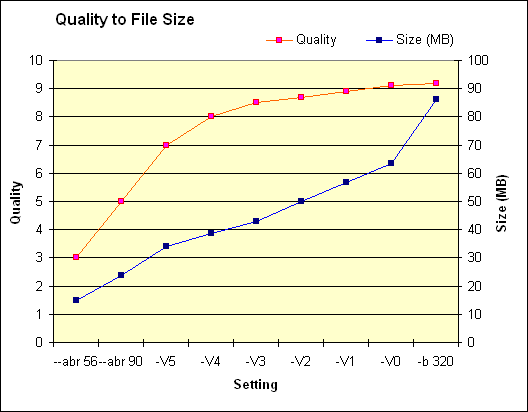
File size increases every bit quality increases, but at a certain signal y'all hit the wall of diminishing returns.
Establish a workflow
With your gear dialed in and all the large decisions made, you lot're ready to dive in. It'due south going to accept a bit of practice earlier things start to experience smooth – the first few records yous rip are going to involve some trial and error, but pretty shortly y'all'll have a satisfying workflow happening. Of course, yous'll need to capture your records in real-time (dissimilar CD ripping, which can happen at upwards to 16x). Add in the time to clean, separate and massage track breaks, wait up metadata and find anthology art, and you can look the process to take nigh an hour per anthology. But you don't need to be nowadays for well-nigh of that time of form – the actual manual interest will be around 5-xv minutes per album, depending on how much tin be looked upwards in databases.
VinylStudio includes excellently detailed documentation on every step of the process, and yous should definitely read up, but here's my overview:
- Create an "Album"
- Tape
- Await up metadata
- Find runway boundaries/divide tracks
- Clean up pops and scratches
- Export (tin be washed in batch fashion)
When yous first gear up VinylStudio (I'll call it VS from here on), it'll ask you to set a recording format. This is not the same as the output format – y'all can output to any format later in the game. Information technology's asking in which format you desire to store the recordings internally. These are the versions yous'll be splitting up into tracks, de-clicking, burning to CD (if you swing that manner) and possibly storing in your long-term high-allegiance storage vault. I chose AIFF 44KHz, 16 bit.
If you're going to export to MP3 later, you'll demand to install the LAME encoder and tell VS where to discover it – the program does not come with its own MP3 encoder for copyright reasons. Follow the directions carefully and make certain you get the recommended version – other builds of LAME come with libraries in formats that VS can't use.
The VS interface is arranged in tabs that mirror the general workflow. Start with the Record tab and enter the Artist and Album, recording year and genre of the LP you want to offset with. This is needed for file and folder proper name creation, your own reference, and to give hints to the "Lookup" feature and then it can find track names and lengths for you later on.
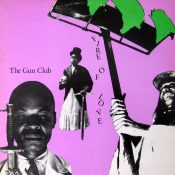
When recording is complete, switch to the Separate Tracks tab and click Lookup Rails Listing. Use the "Database" drop-downwardly to tell VS where to look for metadata – I take the best luck with MusicBrainz and Discogs, simply there are other options. Keep in mind that all of the data in these databases is submitted by cease users like you. That means the album covers will all be shot differently, and the track lengths and placements will be slightly different. Since there are oft many different pressings of the same album, and because people start/finish recording at unlike times, expect to see quite a fleck of variation in these. The nice thing is you tin can mix and friction match – utilise the anthology fine art from one listing, and the runway listing from another, for example. And y'all'll exist able to override any of the discovered information later if necessary.
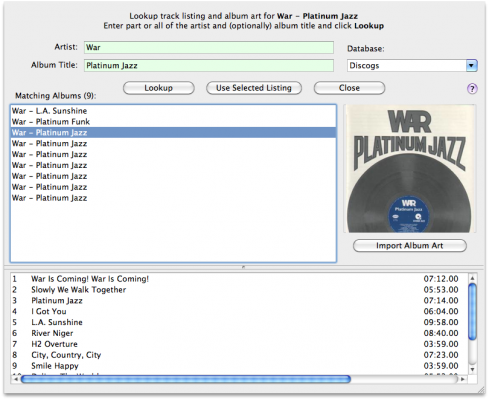
Click Import Album Art when you detect the all-time comprehend shot, and Apply Selected List when you find the runway list that best matches the record you're actually working with. Then click Close.
If you're lucky, all of the suggested rails breaks will pretty much line upward on the waveform with your actual record. In some cases, still, the breaks (the carmine lines) will friction match at commencement, so drift pretty desperately. If this happens, yous have three choices. You lot tin can one) Return to Lookup and try to detect another listing that fits your bodily tracks better, or 2) Continue the listing and arrange information technology manually (not difficult), or 3) Click the Scan for Trackbreaks button and permit VS auto-detect the breaks. The cool matter is, if you attempt approach #three, the actual track titles you got from the lookup will be retained – only the rails lengths will be altered. VS does everything it tin to go on your workflow as pain-costless as possible.
Runway breaks were constitute from a Discogs lookup for this double LP, but they're way off. Manual track alignment is needed with virtually every album – some more than others.
If your record couldn't be found in any of the lookup services, things become a scrap more than manual. Click "Browse for Trackbreaks" and let VS do its thing – about 10 seconds afterwards, you'll see breaks placed at the all-time-guess locations, which are commonly pretty good (just you'll all the same need to massage them). Make sure VS shows equally many tracks are on the actual album – if not, you lot'll demand to report the waveform even more closely to find the ones information technology missed. Place the cursor where y'all want a intermission and hit Cmd-B to insert a new break. When the number of tracks match, double-click the track names in the listing to blazon in the actual titles.
Even though you lot've gotten a big leg upwards by pulling in metadata from Discogs and Musicbrainz, y'all'll quickly realize that the timestamps for the rail breaks retrieved are from other people's recordings – because people hit Record at dissimilar times, they're going to exist off by anywhere from 2-20 seconds, which means you yet need to manually massage every single runway break to get it right.
Some LPs are really difficult to dissever up. For example, my 1953 Folkways recording "Leadbelly'due south Final Sessions." The bands (tracks) on the LP are divided into Band 1, Band 2, Band iii, etc. But within each of those bands are multiple songs. Band 1 actually consists of three unlike songs, with no articulate separator between them. Should I split information technology across bands or endeavor to find the song breaks, which are tough to listen for and aren't visible in the waveform – he's talking in the background between the actual songs. I'd like to have tracks named for songs of course, but it'southward cryptic and going to be an even more manual/time-consuming job than usual. To make matters worse, this is ane of the few LPs I have that tin't be looked up in any of the metadata listing services. The easy way out would exist to but split it on album sides (sides i-4). That would leave me with no metadata at all, but would be far easier. Fortunately this kind of state of affairs doesn't come too often, but when it does, you just have to make judgement calls. In this particular case, I decided to discard the encoding and just keep the LP.
At present to finesse the breaks – the virtually transmission office of the process. Start past zooming in shut – you can use either the +/- icons, or the scroll bike on your mouse. Note that each track pause has a double-concluded arrow at the tiptop – green for start, red for end. You can turn the breaks into "gaps" by holding downwards the Shift central and dragging the pause line. This creates a shaded area that will be excluded from the last output. The general process is:
- Zoom in, elevate the playhead (the black line) to the area you want to study, and utilize the Spacebar to start/terminate playback. Move the playhead to a position close to the end of a track, hit Spacebar, and listen until the rails fades to absolute silence, then hit Spacebar again to stop playback.
- Drag the track break line to the to the black playhead line.
- If y'all want to cut out some of the space (and so at that place aren't long silences at the get-go and end of your output tracks), hold downwards Shift while dragging the break line. As yous drag, a shaded gap will become visible.
- Hit Spacebar once again and playback volition resume from the end of the gap. Suit the in- and 0ut-points for the gap until there's nigh a 2d of silence earlier/later on detectable sound of the previous/next runway.
Pictured: The auto-discovered runway break was off by well-nigh fifteen seconds. Fixing this was a four-stride procedure: Listen/view for the correct finish of the previous track and put the playhead in that location; Move the suspension line to the cursor line; Shift-drag the break line to create a gap; Dial in the position for the cease of the gap.
When your track splitting work is done, the waveform should look something like this, with some tracks being separated by gaps (especially between anthology sides), others not.
With splitting done, it'due south time to determine whether the recording will sound ameliorate with the audio cleaned upward or non. Since there's a small impact on audio quality with every correction you make, you lot want to go along these to a minimum, and only use them on an as-needed basis. In truth, I found that most of my records had enough pops and crackles to make it worth applying click correction to nigh records. Utilize your ears, and utilize your sentence.
Go to the Cleanup tab and find the icon on the bottom toolbar that looks similar a double-ended checkmark (circled in red here), which is the Browse for Clicks option. VS will bear witness a dialog with a agglomeration of sensitivity options. These are well-documented, and all I can say is "read and experiment." I just took the defaults with nigh recordings.
Red circumvolve: The click removal tool. Red square: Toggle click protection on or off.
The process will have a infinitesimal or 2, depending on the speed of your computer.
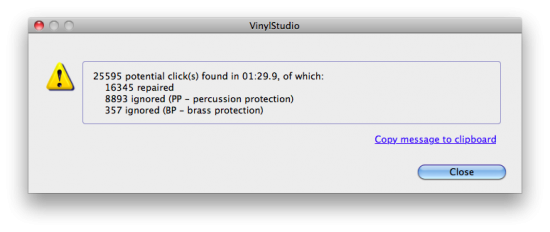
It's pretty amazing how many clicks VS will find and remove – don't be surprised to run across the final count measured in thousands.
Once the process is consummate, it'southward time to put on your ear goggles and listen carefully with click removal on and off. Apply the gamma symbol icon (outlined with cerise square above) to toggle. Check both dense and sparse passages, listening advisedly for the impact of click removal on tonality and range. The difference will be fairly subtle if you used VS's default settings, only it is noticeable. Over again, y'all'll want to make this judgement on a per-tape footing. If a record is in great shape, y'all'll exist better off not using click protection.
Now you're ready to export. Select the Relieve Tracks tab and you'll come across a list of all the albums you've recorded. You can either export your albums to MP3 one at a time, or exercise them in batches (I'm doing them in batches of effectually a dozen). Dig effectually and y'all'll find options to select the output format, chip rate, and whether to accept albums added to iTunes. Since the MP3 encoding process can take a while when batch processing, this is something yous might desire to do once a calendar week, before going to bed.
When export is complete, switch over to iTunes and select the Recently Added playlist. Brand sure all of the recently added tracks have solid metadata (they should at this bespeak) and album art. If you weren't able to find album art in the Lookup stage, now is the time to search for the album championship in Google Images and relieve the highest quality album embrace you can find to your desktop. Select all the tracks in that album, hit Cmd-I, and drag the image from the Finder to the Artwork foursquare in the iTunes info panel. Alternatively, yous can endeavour the Pollux shareware app to retrieve missing metadata and cover art, but I found I didn't need it much.
Keeping Archival Copies
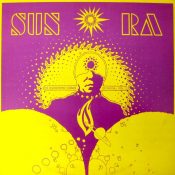
- Set internal Album recording format to AIFF
- Procedure a dozen or so albums, skipping the Salve Tracks (export) step
- Before going to bed ane night, go to Save Tracks, select all, and output to MP3 VBR0 (and import to iTunes)
- Delete all the saved Albums from the Save Tracks tab.
If I wanted to keep the high-resolution AIFF originals in an annal, I would simply skip footstep #4, and manually copy those AIFF files from the Finder to a long-term storage bulldoze or service.
That's information technology! Y'all're digitalized, baby. Go along at it – you should be able to complete 2-3 albums a day during the work week and more on the weekends. I expect I'll exist at information technology for the meliorate part of 2011… before pillaging my friends' collections for more :)
Update, end of 2011: At that place were effectually 500 LPs birthday, merely many I had since besides acquired on CD or MP3, and so didn't need to exercise those. Likewise skipped quite a few that were simply too surface noisy. That left around 300. Hither'southward a trivial screencast of the ones that actually needed digitizing. I also got really anal about finding skillful cover art. What I couldn't observe on the net, I photographed myself.
Once yous cease digitizing your collection, see likewise:
How To Listen to Your Home iTunes Collection from Work
Source: http://blog.birdhouse.org/2011/02/20/digitizing-lps/comment-page-1/
0 Response to "I Am Strangely Glad to Get Back Again to You and Wherever You Are Is My Homeã¢â‚¬â€my Only Home"
Post a Comment